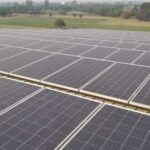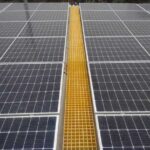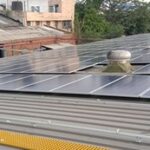Everything You Need to Know About Solar PV Modules
Everything You Need to Know About Solar PV Modules
Photovoltaic (PV) modules are the essence of a solar power system, often referred to as solar panels. These panels constitute multiple solar cells, which are made of semiconductor materials like silicon. They are usually protected by glass layers, a backsheet, and a strong aluminium frame. A junction box is also connected at the back to connect the module with the electrical system.
The sunlight striking the solar cells creates an electric current, and this process is called the photovoltaic effect. This generated electricity is then used to power houses and businesses.
Switching to PV modules is now a need, as sunlight is converted into clean and renewable electricity. This reduces our reliance on fossil fuels and can be easily mounted in both residential and large-scale solar farms.
Types of PV Modules Used Today
Different PV modules or solar panels are available in the market now. Choosing the right type, according to their qualities, is essential as not all PV modules are the same. PV modules differ in their materials, efficiency, design, and applications, and these differences matter when choosing the right system.
Today’s solar industry offers various classifications:
Monocrystalline vs Polycrystalline
- Monocrystalline modules are made from single-crystal silicon, while polycrystalline modules use multiple silicon fragments.
- Monocrystalline panels are more efficient in nature, while polycrystalline panels are more affordable.
P-type vs N-type
- P-type modules are dominating the market currently, but N-type modules have been in demand due to higher efficiency and better durability.
- P-type panels one up to 550Wp, while N-type panels can go up to 720Wp.
Bifacial vs Monofacial
- Bifacial modules can easily capture sunlight on both sides, while monofacial modules only generate power from the front.
- Due to the bifacial availability, it boosts the overall energy generation as compared to monofacial modules.
Thin-film
- Choosing flexible and lightweight panels will not be that efficient, but it will excel in different niches. Materials like cadmium telluride (CdTe) or amorphous silicon used to manufacture thin film, has been superseded by better alternatives.
The Evolution of Solar PV Modules
The solar industry has been shaped by decades of innovation. Here’s a timeline of the most important PV module technologies:

TOPCon (Tunnel Oxide Passivated Contact)
- Introduced: 2020s (rising dominance)
- Cell type: N-type silicon with passivated contact layer
- Efficiency: 23-24.5%+
- Use case: Next-generation residential and utility-scale projects
- Role: Represents the cutting edge of commercially available PV modules, pushing solar toward 25% efficiency.
Old-Standard Mono and Poly (Legacy Panels)
- Introduced: 1980s-1990s
- Cell type: Monocrystalline and polycrystalline silicon
- Efficiency: ~12-15%
- Use case: Early residential and commercial solar systems
- Role: Pioneered commercial solar adoption, but was limited in efficiency compared to modern tech.
Poly PERC
- Introduced: Early 2010s
- Cell type: Polycrystalline with Passivated Emitter and Rear Contact (PERC)
- Efficiency: ~16-18%
- Use case: Affordable rooftop and utility-scale systems
- Role: Marked the shift to better light absorption and improved module performance.
Mono PERC
- Introduced: Mid-2010s
- Cell type: Monocrystalline silicon with PERC
- Efficiency: ~18-21%
- Use case: Became the industry standard for high-performance modules
- Role: Helped solar achieve mainstream affordability and efficiency.
Thin Film
- Introduced: Commercialized in the 2000s
- Cell type: Cadmium telluride (CdTe), amorphous silicon, CIGS
- Efficiency: ~10-14% (but improving)
- Use case: Utility-scale farms, building-integrated solar
- Role: Lightweight, flexible option for special installations.
IBC (Interdigitated Back Contact)
- Introduced: 2010s
- Cell type: Monocrystalline with rear contacts
- Efficiency: ~20-23%
- Use case: High-efficiency rooftops, space-constrained sites
- Role: Eliminates front-side metal shading, maximizing sunlight capture.
HJT (Heterojunction Technology)
- Introduced: Late 2010s
- Cell type: Hybrid of crystalline silicon and amorphous silicon
- Efficiency: ~21-24%
- Use case: Advanced commercial projects, high-end residential systems
- Role: Combines high efficiency with excellent temperature performance.
Efficiency and Cell Design: How Far We’ve Come
The difference between older and modern solar panels is dramatic:
-
Efficiency gains
From approx. 12% in the 1990s to 24%+ today.
-
Cell structure
Evolved from full cells to half-cut, multi-busbar, and back-contact designs.
-
Wafer sizes
Scaled from 156mm → 158.75mm → M6 → M10 → G12, allowing more power per panel.
-
Performance upgrades:
- Bifacial modules generate power on both sides.
- Better temperature coefficients mean panels perform more consistently in hot climates.
- Degradation rates have dropped, ensuring modules last longer with higher lifetime yields.
Modern solar modules are more efficient, smarter, more durable, and optimized for real-world conditions.
Choosing the Right Module for Your Needs
Understanding PV module evolution isn’t just technical but rather a practical guide for making better investment decisions. It is important for houseowners and businesses to consider the following aspects:
Budget
Legacy panels are cheaper, but modern tech offers higher returns over time.
Space
Limited rooftop? Go for high-efficiency modules like N-type, TOPCon, or HJT.
Power needs
Larger households or energy-hungry businesses benefit from higher-output panels.
Location
Hot or dusty climates may favor technologies with better temperature and degradation performance.
Warranty
Look for panels with long-term performance guarantees (20–30 years).
Conclusion
The journey of PV modules, from basic monocrystalline panels to today’s TOPCon and HJT technologies, shows decades of relentless innovation and growth. Each module has delivered higher efficiency, better performance, and lower costs, making solar energy a widespread solution.
The future potential, with the emerging technologies like tandem cells, perovskite-silicon hybrids, and building-integrated photovoltaics (BIPV), promises to improve efficiency even higher.
At Smart Roof Solar, we aim to help you go solar entirely. From the best quality panels to the post-installation services, we’re ready to help you interpret these technicalities so you can optimize your solar journey seamlessly. Connect with us now to choose renewable and clean energy.
FAQs
Q1. How long do solar panels typically last?
Ans: Most modern solar panels last 25 to 30 years, with many still producing electricity beyond that, though at reduced efficiency.
Q2. What is the difference between solar cells and solar panels?
Ans: Solar cells are individual units that convert sunlight into electricity, while solar panels (modules) are made by combining multiple solar cells into one unit.
Q3. Can I install solar panels if I have limited roof space?
Ans: Absolutely. High-efficiency panels like HJT, IBC, or TOPCon are ideal for rooftops with space constraints as they generate more power in less area.
Q4. Do solar panels require a battery to work?
Ans: Not necessarily. On-grid systems don’t need batteries, but off-grid or hybrid systems do if you want power backup during outages.
Q5. Can solar panels damage my roof?
Ans: No, if installed correctly. In fact, they can protect your roof from weathering. Poor installation, however, can lead to leaks, so choose certified installers.
Suggested Articles

PM Surya Ghar Muft Bijli Yojana 2025: Online Registration Made Simple
PM Surya Ghar Muft Bijli Yojana 2025: Learn how to register online and get free electricity under this government scheme.

How to Improve Energy Efficiency and Save Electricity Costs
Learn how energy conservation and efficiency can help you save electricity, cut costs, and make your home or business more sustainable

Why Is Investing In Grade A Panels Important?
Investing in Grade A solar panels guarantees superior performance, safety, and maximum return on your solar investment.

Is Your Solar PV Rooftop System Safe & Protected?
Worried about the safety of your solar rooftop system? Explore key tips, maintenance practices, and protection strategies to keep your Solar PV system secure and efficient

Industrial Solar Power: 7 Reasons to Make the Switch
Top 7 benefits of solar energy for industries, including cost savings, environmental impact, and improved energy reliability.

Solar Chankya: Complete Guide to Solar Systems and Components
Discover the key components of solar systems—from panels to inverters and batteries—and how they work together for efficient energy solutions

Solar Loans, Subsidies & EMI Plans: Financing Made Easy
Explore solar loans, government subsidies, and flexible EMI plans to make installing solar panels affordable and hassle-free.

Commercial Solar Power Plant Subsidy in India: What Businesses Need to Know
Businesses in India can reduce their solar installation costs through various MNRE-backed subsidies and state incentives. Learn eligibility, benefits, and the application process for commercial solar plants.